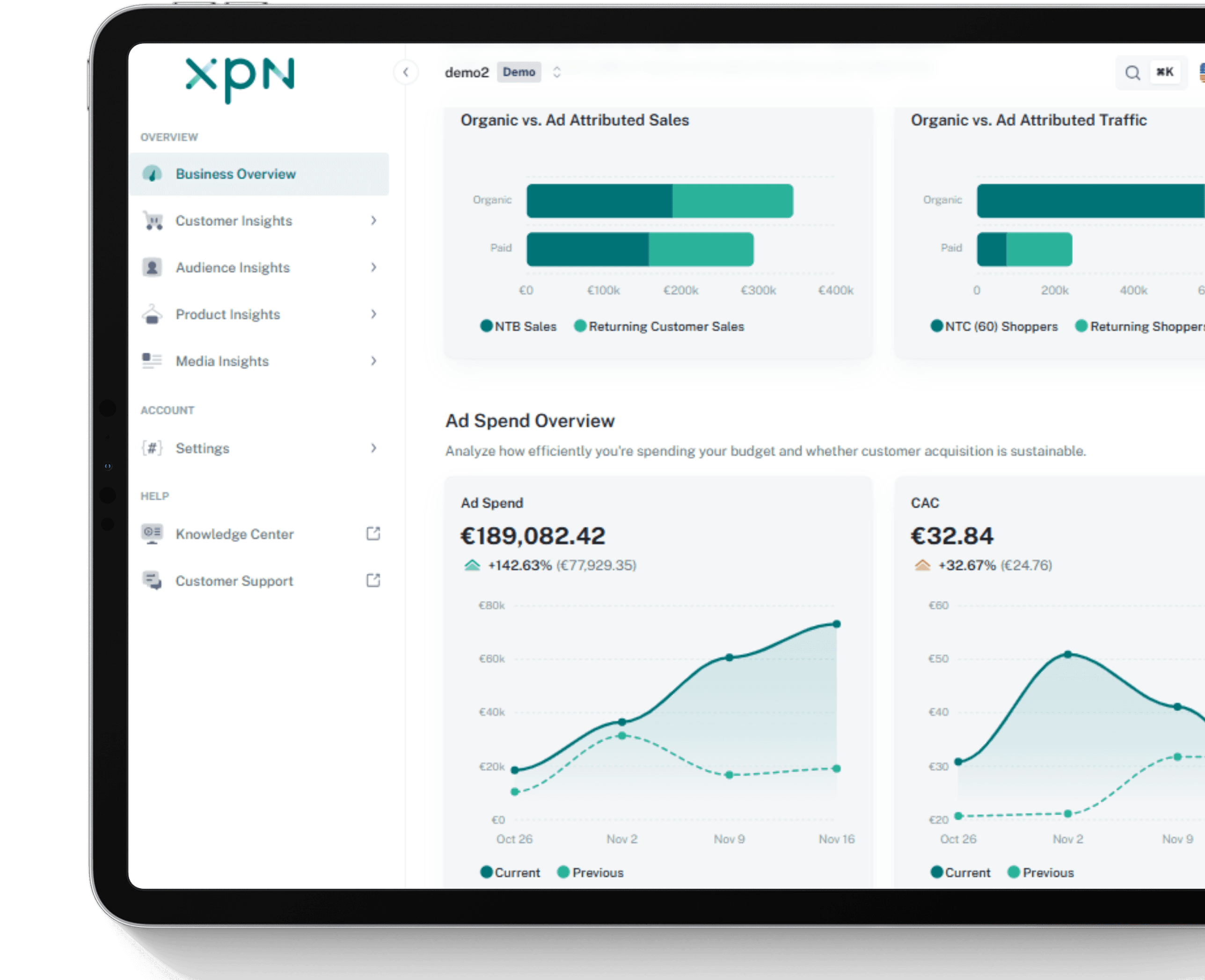Advertising Analytics
08/30/24
Customer Lifetime Value and Acquisition Costs: Leveraging for long term growth on Amazon
There are two metrics that are relatively new to the Amazon advertising space; Customer Lifetime Value (CLV) and Customer Acquisition Cost (CAC). These metrics are used in many other consumer businesses, but because Amazon does not publish these metrics in seller central or its advertising console, many Amazon sellers have been slow to adopt them.
However Amazon is providing increasing access to customer data through its data clean room, Amazon Marketing Cloud (AMC) and CLV and CAC are two metrics that AMC can be used to calculate. In this article we'll dive into what is CLV and CAC and why you should be using these metrics for long term brand growth.
What is CLV?
CLV or Customer Lifetime Value is the average amount of money a customer spends with you over the period of time they remain your customer. It tells you how much each new customer will be worth to your business over time. Knowing this metric will help you understand how much you should spend on marketing and customer acquisition and will help you stay profitable.
Calculating Customer Lifetime Value
So how do you determine your CLV. The formula is:
CLV = (Customer Value x Average Customer Lifespan).
Let's break this down further. To get these numbers a few more metrics need to be calculated including Average Order Value, Average Purchase Frequency, Customer Value and Average Customer Lifespan, which will then get you to Customer Lifetime Value.
How to Calculate Lifetime Value
1. Average Order Value
Choose a time period to calculate your AOV. A year or so will likely give you enough data to be accurate, but keep in mind any changes to your price point or product line that may have impacted it recently. Then to calculate AOV the formula is:
Average Order Value = Total revenue within a time period / Number of orders within that time period.
You can also get AOV from Amazon's business reports under Average Sales per Order Item.
2. Average Purchase Frequency
Next you'll need to know your average purchase frequency, or how often your customer buys from you. To do this you can use the following formula:
Average purchase frequency rate = Total number of Orders / Total Number of Customers
Use the same time period you did for AOV. However this is where it gets tricky with the metrics Amazon has available in Seller Central and its advertising console, it shows orders, but not # of customers. This is where you would need to pull order data and process the data to find unique customers, or use Amazon Marketing Cloud data.
3. Customer Value
With AOV and purchase frequency calculated you then can get to Customer Value for the time period by using the formula:
Customer Value = Average order value x Average purchase frequency
If you are using a year for your time range, this is how often customers purchase within a year.
4. Average Customer Lifespan
Next we need to answer the question, how many years does a customer shop with you? You can use the formula:
Average Customer Lifespan = Sum of all customer lifespans / Total number of customers.
This can be harder to calculate for your Amazon customers given that Amazon Marketing Cloud data is only available for the previous 12.5 months at any given time and the anonymized data produced by AMC does not let you conjoin multiple periods over time.
So, right now, the best practice is to track this data in your D2C sales channels such as your website.
5. Customer Lifetime Value
With the above calculations done we can now determine CLV using the following formula:
CLV = Customer Value x Average customer lifespan
Given that it can be difficult to determine total customer lifespan using Amazon data, whether or not you can actually calculate lifetime customer value is up for debate. But you can certainly calculate the value of a customer within a 12 month period, which can help you determine your target customer acquisition costs. You can also use your 1P and D2C data to calculate the above and make some assumptions about how it applies to your Amazon customers.
Why You Should Care About CLV
So why go through the trouble of gathering all this needed data to get to customer lifetime value? There are at least two major reasons; it gives you a measuring stick to gauge where your customer acquisition costs should be and tracking CLV over time can help you spot changes and improve marketing efforts in improve loyalty and retention.
Control Acquisition Costs
If you don't know how much a customer is worth, how will you know how much to spend to land them in the first place? Many advertisers have fallen into the trap of only focusing on ROAS or ACoS in their advertising campaigns. While this is a valuable metric and can help you measure short term profitability, it does not tell the whole picture. If you knew that an average customer was worth $2,000 over its lifetime, how much would you be willing to spend on marketing to introduce them to your brand?
Boost Loyalty & Retention
By tracking CLV over time you can spot trends and opportunities to increase customer loyalty, and you can also measure how well your retention efforts are working. Tracking CLV will help you make data driven decisions to increase the long term profitability of your brand by creating the right marketing strategies to boost loyalty and increase CLV.
What is CAC?
Customer acquisition cost, or CAC, it the cost associated with acquiring a new customer. How much was spent on marketing activities to attract a first time purchaser of your brand?
Calculating customer acquisition cost
CAC is more simple to calculate than LTV. First determine your time period; a year, quarter, month or other time range then use the following formula:
CAC = Total Sales and Marketing Expenses / Number of New Customers
In the Amazon marketplace most brands will use total ad spend across Sponsored and DSP advertising as their total marketing expense. As for number of new customers, this again becomes tricky unless you are using Amazon Marketing Cloud as new to brand customers are not reported for Sponsored advertising in the ad console, but is available in AMC. Also keep in mind that Amazon defines a new to brand customer as someone who has not purchased from the brand in 12 months. So if you have an average purchase frequency of more than 12 months, Amazon may not give you the data you need.
Understanding CLV:CAC ratios
With CLV and CAC calculated you can turn this into a ratio that helps you quickly see what your profitability is per customer. For example, if your CLV is $500 and your CAC is $50, your CLV:CAC ratio is calculated by CLV / CAC so $500 / $50 = 10
What Do Different CLV:CAC Ratios Indicate
CLV:CAC = 1
This indicates that for every dollar spent on advertising, you are getting $1 back in lifetime customer value. Which is not great considering that you still need to factor in COGS, selling fees, shipping, etc. This is not sustainable long term and suggests a need to overhaul advertising strategy.
CLV:CAC < 1
A ratio below 1 indicates you are losing money on your advertising efforts, even before factoring in other selling fees. This is obviously also not sustainable and indicates a need to revisit ad strategy.
CLV:CAC > 1
A ratio above a 1 is where brands want to land. Different categories have different idea ratios, ecommerce typically has a 3:1 ratio. If you are lower than this industry benchmark a look at marketing efforts again may be in order.
How to improve CLV:CAC ratio and profitability
So now that you know your CLV:CAC ratio what do you do next?
Customer Purchase Frequency
How frequently a customer purchases a product from your brand can increase your ratio and profitability. Are there other products they may be interested in? Are they aware of new product launches? What else can encourage them to come back to your brand and purchase again? Amazon's display ads can be used to re-market to past purchasers, just be sure that cost doesn't outweigh the increase in revenue.
Utilize Subscribe and Save
Amazon's subscribe and save is a great way to increase LTV and your CLV:CAC ratio. It will cost you in the form of a 5% or more discount, but it's a good way to decrease churn rate and increase customer retention when they are ready to order a replacement for consumable items such as beauty, grocery or personal care.
Customer Average Order Value (AOV)
How can you encourage customers to spend more with each purchase? One way is to utilize and drive traffic to your brand store on Amazon. By leveraging Sponsored Brand ads to send traffic to your Amazon storefront you will be exposing the customer to your full catalog instead of just an individual product, creating opportunities to cross sell and upsell as they browse your catalog.
Advertising optimization
Reviewing your advertising campaigns for wasted spend should be happening on a regular basis. This is not just an exercise in ROAS, since any top of funnel campaigns will by nature have a lower ROAS. You need to be able to see the full customer journey, cost of acquisition, customer retention rate and more. Did your video ad lead to a brand search then a Sponsored Brand ad, then a retargeting ad which led to the purchase? Or are prospective customers dropping off after the video ad?
To do this kind of analysis as an Amazon advertiser, you will need an AMC instance to access this data, it's not in the advertising consoles. Key metrics you will need include path to purchase, media overlap, multi touch ROAS can all be generated using Amazon Marketing Cloud and can give you insights on how those top of funnel campaigns contribute to purchases.
Customer lifetime value and acquisition cost are just two of many KPIs that marketers should be considering as they create marketing strategies for their brand. Using these metrics alongside others will help you ensure that you are spending advertising dollars in the right places, the impact of those dollars on attracting and retaining a solid customer base, and ultimately, grow your brand profitably.
--
Need help improving your Amazon advertising measurement and reporting? Contact XPN today, an Amazon Verified Partner, for a free demo of our Amazon Marketing Cloud based dashboards that will help you unlock data around your customer's purchase journey.


